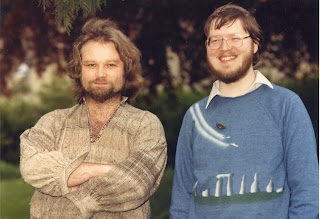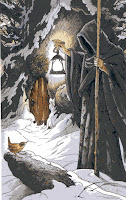Christmas Eve has come and now I can truly rest.
Every year we try to have the Twelve Days of Christmas as a complete holiday,
though a copy editor came near to spoiling that this afternoon by giving me
work ‘to be handed in on 6th January.’ I’m afraid I just turned it
round very quickly, completely unwilling to extenuate a piece of rewriting
through my precious quiet time.
As we approach the next few quiet days from work,
this is a good time to refresh how we can really prepare for the year ahead of
us through the medium of the Twelve Days of Christmas, which in this household
are well kept.
In the medieval liturgical calendar, the
festival of Christmas Day stood alone by itself as a supreme holy day, and so the
counting of the twelve days began from 26 December which is the 1st
day of Christmas until the 6th January which is Twelfth Night, or the 12th
day of Christmas. What has this got to
do with anything?
Well, in Brittany
and in Wales
Brúg na Boinne
Within these twelve days lies a wonderful secret
that those dismissive of the Christian tradition might well miss, for each of
the twelve days is assigned to a month of the coming year, with the first day
of Christmas the 26th December as symbolic of January, the second
day or 27th December representing February and so on, right through
to 6th January which represents the December yet to come. It was the custom of many to go out on each
day of the Christmas festival to observe the signs in nature and divine from
them the state of the year to come. The omens experienced on each of the Omen
Days indicate the nature of each month in the coming year.
The
divining of oracles from nature has a long tradition in Celtic lore. The Scots Gaelic tradition of the frith or the augury from the signs of
nature is well established. The listening to bird’s calling was a critical part
of druidic lore, as was the movement and behaviour of other animals. Some of these auguries have come down to us,
like the little white book of meanings in a tarot pack: some people used them,
but others did not. The real skill is to
read the signs in accordance with your understanding at the time, and as it
relates to the question that provoked the augury in the first place. I’ve been teaching this skill for over 25
years and not yet found anyone who couldn’t do it, as long as they first asked
a well-framed question.
Omen in the Sand, Bay of Scail, Orkney
In
this case, you treat each day of Christmas as the opportunity for an augury for
the month it represents in coming year. This might be experienced during a daily walk,
or perceived in the nature of the day itself and how it falls out. Personally,
I like to make a frame for each Omen Day, by asking to be shown an augury from
nature and allowing the next thing I experience, see or hear to be the sign I
am expecting. It helps to find the right
place to do this on a walk, to close your eyes, to spin around on the spot and
then be attentive.
Many
of my students have been doing this for a while and last year I shared it with
an online group of Lenormand Card readers, who are now using the Omen Days to
divine for the year ahead, choosing one or more cards each day to discover the
nature of the months of the year. There
is no right way to do this, only by the unique interaction you have between the
world that is seen and the world that is unseen, but just as real.
That the Twelve Days of Christmas have kept
their assured place at the heart of Celtic divination is one of those wonderful
instances of double-decker belief that are scattered throughout folk tradition
worldwide. The Russians have a good word for this kind of thing, naming it dvoverie or ‘double-belonging,’ a word originally
coined to cover those who had an earlier belief running alongside a later
one. Wherever a newer tradition has come
into a country, the older one doesn’t just die or go away, but becomes fused
with the newer one, so that the traditional continuity can be enjoyed by us
all.
Whatever your beliefs, the Omen Days continue
to offer the opportunity to understand the year ahead so, forget the ‘year’s
round up of news’ and the ‘look-back specials’ on the tv this Christmas and
look ahead to a year full of promise!
I wish you and yours joy, health, love and
peace!
The Green & Burning Tree from
Celtic Book of the Dead by Caitlín Matthews,
art by Danuta Meyer
Caitlín will be teaching Celtic
methods of divination from nature on 15-16 February 2014 Celtic Visions: Seership, Omens
and Divination from Nature This non-residential course explores the realm of Celtic divination
and vision that was once the preserve of the druidic seers of the Celtic world
who used subtle perception to reveal nature's truth and the soul’s
knowledge. Caitlín has made a special
study of the oracular and sacred traditions, finding simple, practical ways by
which these methods can illuminate the present moment. Participants will learn
how to read the omens of the natural world, using traditional seership methods,
including 'the Three Illuminations' - ancient Irish modes of oracular
divination by incantation, resonance and shamanic incubation - and 'the Augury
of Brighid' which was employed by the ancestral freers of Gaelic
Scotland. There will be opportunities to
give and receive oracles and auguries, by means of the dha shealladh
or 'the two seeings' and by other traditional methods.
Participants need to bring a wooden
staff or wand, OR a small smooth stone, a covering for their eyes, and a small
personal object which should be one whose history is known to them and that
they don't mind other people handling – it will return home with them. NOTE: we
will be spending short periods outside regardless of weather.
Fee:
£175, send £75 deposit payable to the Clophill Centre, or directly into the
account of Richard Diss, sort code 09.01.28 a/c 40762541 Enquiries
to Clophill Centre, Shefford Road, Clophill, Beds. MK45 4BT. richarddiss1950@tiscali.co.uk or
01525 862278
If you can’t
come, then this course generated a book on Celtic seership called, Celtic Visions: Omens, Dreams and Spirits
of the Otherworld is available from her at www.hallowquest.org.uk or from all
the usual sources.



















